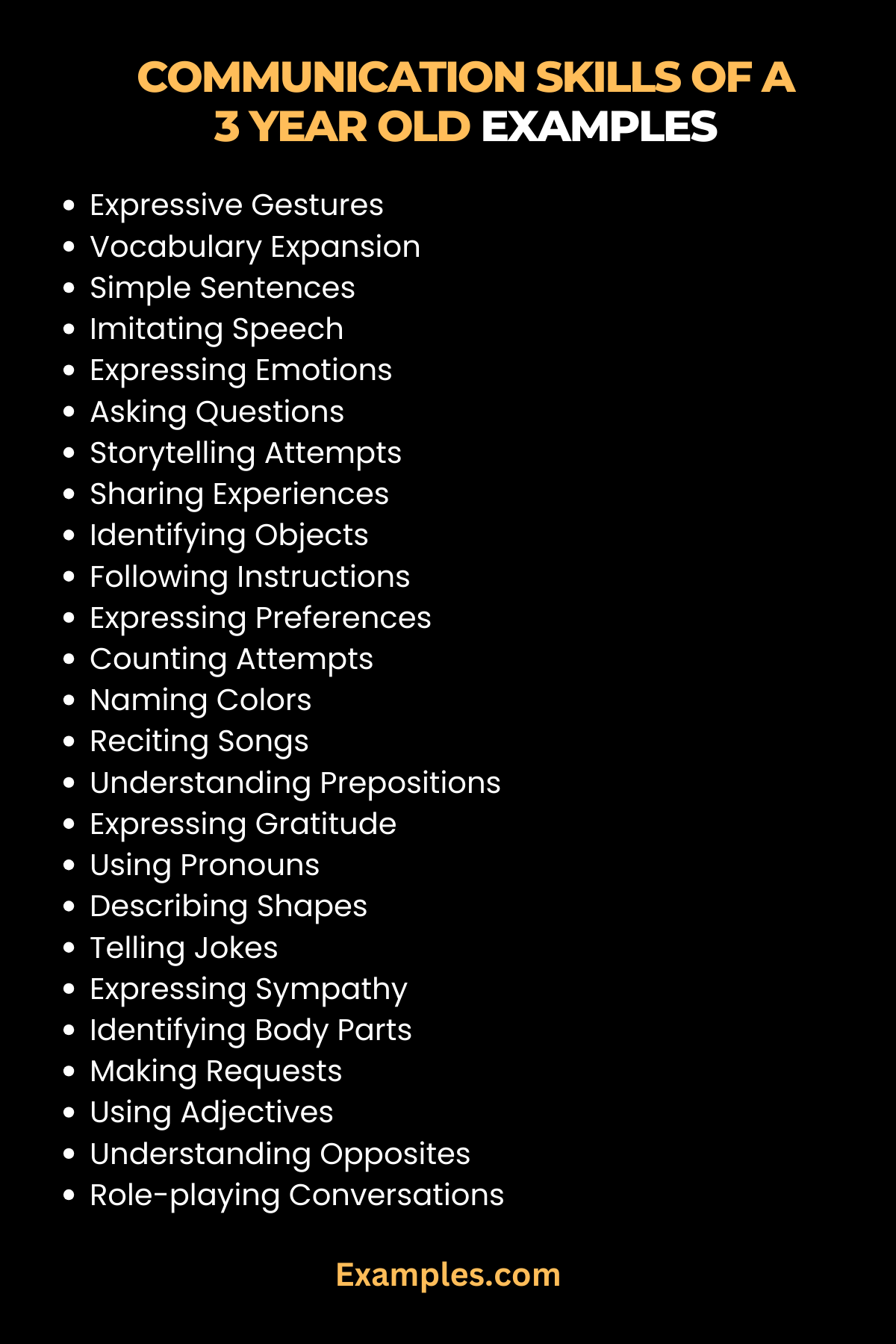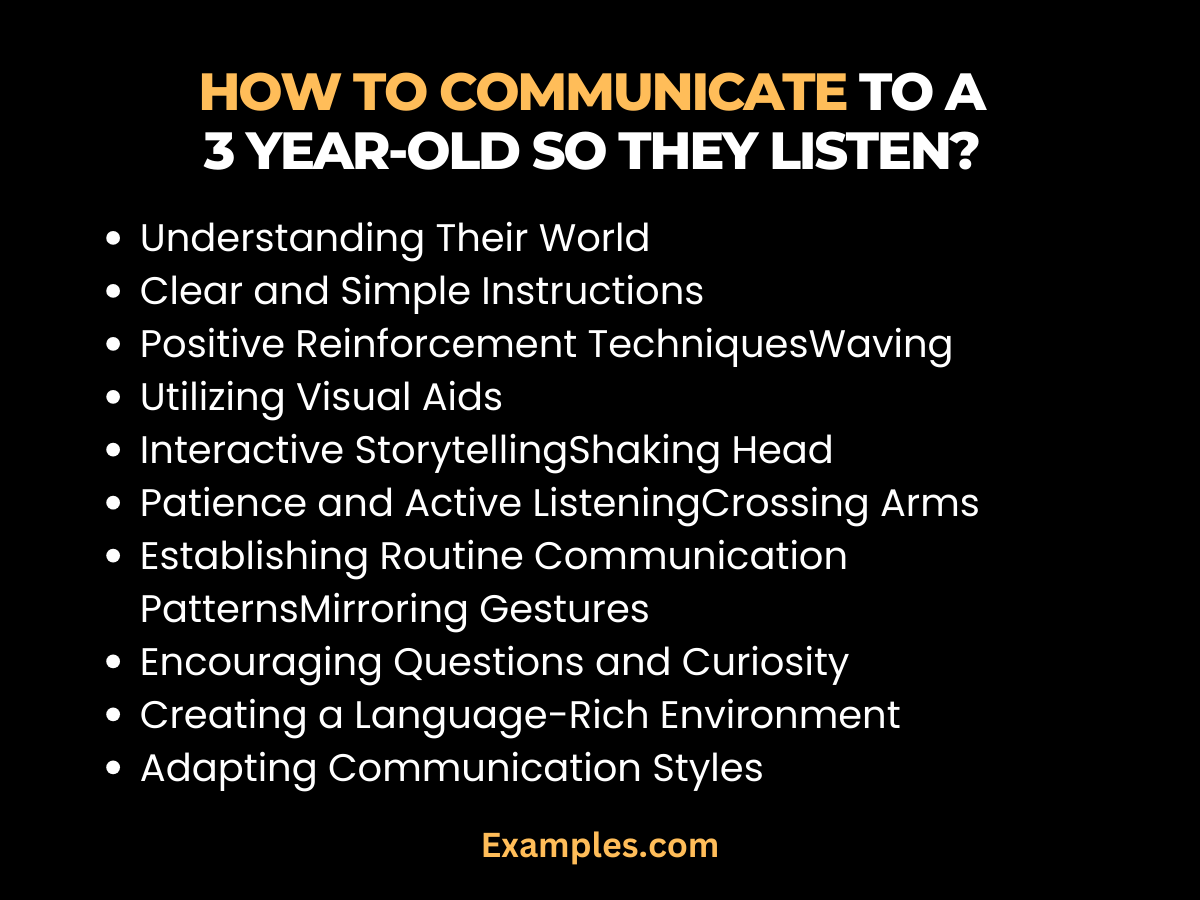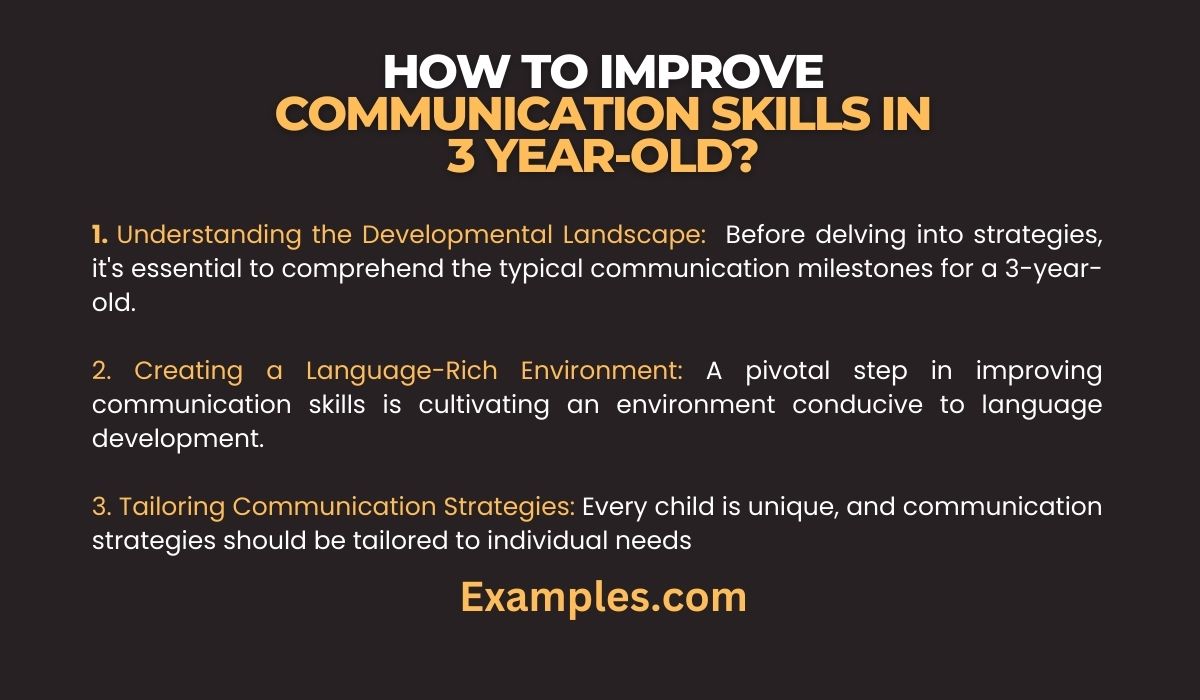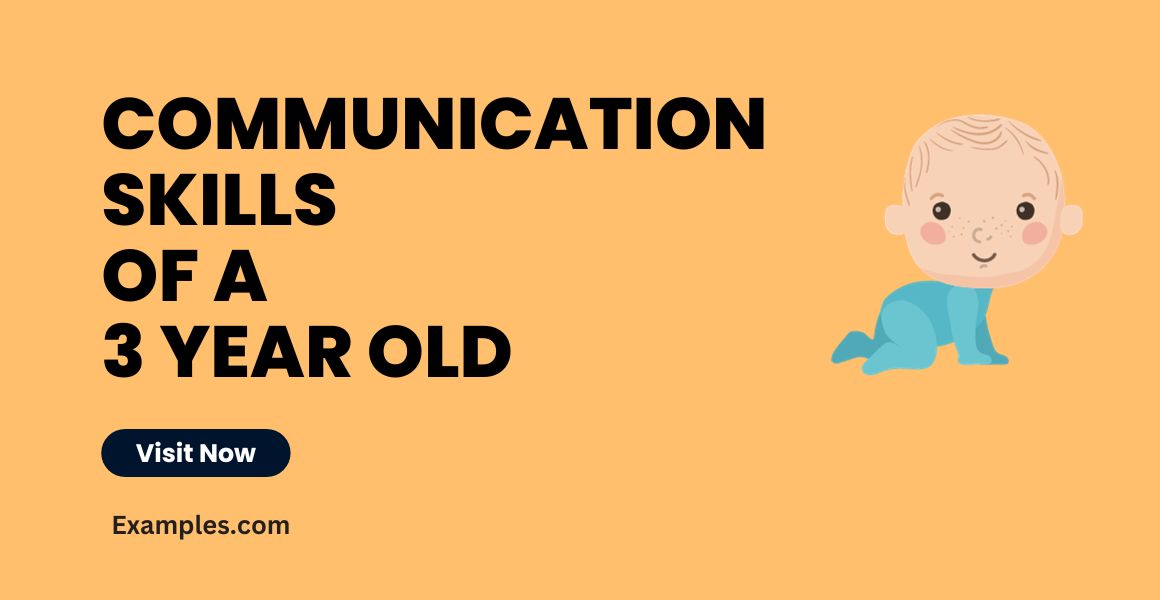29+ Communication Skills of a 3 Year Old Examples
Unlock the secrets of fostering impeccable Communication Skills in a 3-year-old with our comprehensive guide. Navigating the nuances of toddler talk becomes a joy as we delve into practical tips and vivid examples. This guide, enriched with insights on effective communication strategies, is tailored for parents seeking to nurture their child’s early verbal development. Embrace the journey of Communication Examples that make learning engaging and impactful for your little one.
What is Communication Skills of a 3 Year Old?
In simple terms, Communication Skills in a 3-year-old encompass their ability to express thoughts, emotions, and needs through words, gestures, and body language. This vital developmental aspect lays the foundation for effective interaction and understanding as they navigate the early stages of verbal expression. As we explore this, we’ll provide a clear and straightforward definition to help parents and caregivers grasp the significance of nurturing these skills during this crucial developmental phase.
30 Communication Skills of a 3 Year old Examples
In the fascinating world of toddler communication, three-year-olds showcase an array of skills that lay the groundwork for effective expression. From simple gestures to budding vocabulary, their communication journey is both adorable and crucial for their development. Explore this concise guide highlighting key aspects of a 3-year-old’s communication skills.

- Expressive Gestures: Bold movements accompany their words, aiding in conveying thoughts effectively.
- Vocabulary Expansion: Bold new words emerge daily, expanding their linguistic repertoire.
- Simple Sentences: Bold attempts at constructing sentences reflect their developing language skills.
- Imitating Speech: With bold mimicry, they mirror adult conversations, honing language patterns.
- Expressing Emotions: Boldly conveying feelings through words, fostering emotional intelligence.
- Asking Questions: Boldly fueling curiosity, they inquire about the world around them.
- Storytelling Attempts: With a bold imagination, they create simple narratives, exploring creativity.
- Sharing Experiences: Boldly recounting daily adventures, fostering conversational skills.
- Identifying Objects: With bold naming, they label objects, enhancing vocabulary.
- Following Instructions: Boldly comprehending and executing simple commands.
- Expressing Preferences: Boldly asserting likes and dislikes to communicate personal choices.
- Counting Attempts: With a bold foray into numbers, they attempt counting sequences.
- Naming Colors: Boldly identifying colors, adding a vibrant dimension to their language.
- Reciting Songs: Boldly singing familiar tunes, integrating music into communication.
- Understanding Prepositions: Boldly grasping spatial concepts, enhancing comprehension.
- Expressing Gratitude: Boldly saying “Thank you” and learning politeness in interactions.
- Using Pronouns: Boldly navigating pronoun usage, personalizing language.
- Describing Shapes: Boldly recognizing and naming shapes, incorporating geometry into dialogue.
- Telling Jokes: With a bold sense of humor, attempting simple jokes for playful communication.
- Expressing Sympathy: Boldly saying comforting words, showing empathy in communication.
- Identifying Body Parts: Boldly pointing to and naming body parts, promoting self-awareness.
- Making Requests: Boldly articulating desires through requests, practicing effective communication.
- Using Adjectives: Boldly incorporating descriptive words, adding detail to their expressions.
- Understanding Opposites: With bold exploration, grasping the concept of opposites.
- Role-playing Conversations: Boldly engaging in pretend play, imitating various roles in communication.
- Requesting Assistance: Boldly seeking help when needed, building problem-solving skills.
- Expressing Curiosity: Boldly seeking information through questions, fueling a quest for knowledge.
- Naming Animals: Boldly identifying animals and mimicking their sounds, adding fun to communication.
- Recalling Recent Events: Boldly recounting recent activities, developing memory skills.
- Apologizing for Mistakes: With bold humility, learning to say sorry for errors, promoting emotional growth.
What are the 3 Social Communication Skills 3 year Old?
In the formative years of a 3-year-old’s life, social communication skills play a pivotal role in their overall development. This detailed guide delves into the three essential social communication skills that lay the groundwork for effective interaction and connection with peers and caregivers.
Understanding Nonverbal Cues: Mastering nonverbal communication is a cornerstone for any toddler. Explore how 3-year-olds express themselves through gestures, facial expressions, and body language. Unravel the significance of nonverbal cues in establishing connections and conveying emotions.
Navigating Turn-Taking Dynamics: One of the first social skills a 3-year-old encounters is the art of turn-taking. Delve into the developmental importance of this skill in fostering cooperation and communication. Learn strategies to encourage seamless turn-taking in various social contexts.
Developing Shared Attention: Shared attention is a key social skill that blossoms in 3-year-olds. Discover how toddlers learn to focus on and share their focus with others. This section explores the cognitive and social benefits of shared attention and provides practical tips for its development.
Examples of Social Communication Skills:
- Imitating Gestures: Witness a 3-year-old mirroring gestures, a sign of social awareness and engagement.
- Sharing Toys: Explore the joy of a child willingly sharing toys, showcasing early cooperative behavior.
- Joint Attention in Play: Observe the child directing attention to an object, inviting others to share in their exploration.
- Understanding Emotional Cues: Recognize the moment a toddler interprets and responds to the emotions of peers, a crucial social milestone.
- Coordinated Play Activities: Engage in group play where 3-year-olds collaborate, displaying advanced social communication skills.
Strategies for Encouraging Social Communication Skills:
- Modeling Behavior: Demonstrate positive social interactions to provide a behavioral blueprint for the child.
- Encouraging Playdates: Facilitate opportunities for socialization with peers to enhance social communication skills.
- Narrating Social Scenarios: Describe social situations, aiding the child’s understanding and application of social skills.
- Praising Positive Interactions: Reinforce desired social behaviors through positive reinforcement and encouragement.
- Utilizing Visual Aids: Integrate visuals to enhance comprehension and communication during social interactions.
Fostering a Socially Rich Environment: This section focuses on creating an environment that nurtures the development of social communication skills. From the home setting to playgroups, discover how caregivers can actively contribute to a child’s social growth.
How do You Communicate Effectively with a 3 Year Old?
Effective communication with a 3-year-old involves a unique set of strategies tailored to their developing language and cognitive abilities. Mastering this art not only nurtures strong parent-child bonds but also lays a crucial foundation for the child’s future communication skills. In this comprehensive guide optimized for “Communication Skills of a 3-year-old,” we explore actionable tips, insights, and examples to empower parents in fostering clear, engaging, and meaningful communication with their toddlers.
Understanding the Toddler Mindset: To communicate effectively with a 3-year-old, it’s essential to grasp their mindset. At this age, children are curious, imaginative, and eager to explore the world around them. Tailor your communication to capture their attention and align with their inquisitive nature. Use simple language, employ vivid visuals, and embrace a playful tone to create an engaging and receptive environment.
The Power of Visual Communication: Visual aids play a pivotal role in enhancing communication with toddlers. Leverage pictures, drawings, and interactive visuals to complement your verbal instructions. This not only reinforces understanding but also makes communication more enjoyable and memorable for the child. Whether conveying daily routines, teaching new concepts, or sharing stories, integrating visuals transforms communication into a multisensory experience.
Speak Their Language: Adapting your communication style to match the child’s understanding is key. Use short sentences, simple words, and a warm, encouraging tone. Engage in dialogues that invite responses, fostering an interactive exchange. By mirroring their language level, you create a comfortable and accessible space for the child to express themselves, promoting language development and confidence.
Encouraging Active Listening: Effective communication involves not just speaking but also listening actively. Encourage the child to express their thoughts and feelings by asking open-ended questions. Practice reflective listening, acknowledging their statements and providing positive feedback. This not only strengthens the parent-child connection but also cultivates a habit of attentive listening in the child.
Turning Daily Activities into Communication Opportunities: Seize everyday moments as opportunities for communication. Whether during meals, playtime, or bedtime routines, infuse conversations into these activities. Narrate simple stories, describe objects, and discuss emotions. By incorporating communication into daily life, you create a natural and consistent learning environment that supports the child’s language development
How to Communicate to a 3 Year-old so They Listen?
Effective communication with a 3-year-old requires a tailored approach that considers their developmental stage and unique needs. In this comprehensive guide optimized for “Communication Skills of a 3-year-old,” we explore actionable strategies to capture their attention, encourage active listening, and foster meaningful interactions.

1. Understanding Their World: To engage a 3-year-old effectively, delve into their perspective. Appreciate their limited attention span, vibrant imagination, and evolving language skills. Aligning communication with their world sets the stage for a more receptive audience.
2. Clear and Simple Instructions: Crafting instructions that are clear and straightforward is essential. Break down tasks into simple steps, utilizing concise language. This ensures that the child can comprehend and follow through, fostering a sense of accomplishment.
3. Positive Reinforcement Techniques: Encourage positive behavior through reinforcement. Acknowledge and praise their efforts and achievements. Positive reinforcement not only motivates but also strengthens the parent-child bond, creating a conducive environment for open communication.
4. Utilizing Visual Aids: Enhance verbal communication by incorporating visual aids. Visuals can include pictures, drawings, or even simple gestures. This multisensory approach aids comprehension and engages the child’s visual and auditory learning channels simultaneously.
5. Interactive Storytelling: Transform everyday activities into interactive stories. Engage the child with narratives that involve them, making communication a fun and memorable experience. This technique not only captivates their interest but also fosters language development.
6. Patience and Active Listening: Patience is key when communicating with a 3-year-old. Allow them time to express themselves, and practice active listening. This involves giving your full attention, making eye contact, and responding appropriately, creating a communicative environment built on mutual respect.
7. Establishing Routine Communication Patterns: Consistency is vital in communication. Establish routine communication patterns, such as designated talk times or interactive activities. Predictability provides a sense of security for the child, making them more open to communication.
8. Encouraging Questions and Curiosity: Foster a curious mindset by encouraging questions. Responding positively to their inquiries not only nurtures a love for learning but also promotes continuous communication. This open dialogue helps the child feel valued and heard.
9. Creating a Language-Rich Environment: Surround the child with language-rich experiences. Read books, engage in conversations, and expose them to diverse vocabulary. A language-rich environment stimulates cognitive development and enhances their ability to express thoughts and feelings.
10. Adapting Communication Styles: Flexibility in communication styles is crucial. Tailor your approach based on the child’s mood, interests, and energy levels. Adapting to their communication preferences ensures a more receptive audience, making interactions more meaningful.
How to Improve Communication Skills in 3 Year-Old?
Fostering effective communication skills in a 3-year-old is a crucial aspect of their developmental journey. This guide, tailored for parents and caregivers, dives into practical strategies and engaging activities designed to optimize and enhance the budding communication abilities of toddlers. By understanding the nuances of language development and implementing targeted interventions, parents can actively contribute to creating a language-rich environment that sets the stage for lifelong communication success.

Understanding the Developmental Landscape: Before delving into strategies, it’s essential to comprehend the typical communication milestones for a 3-year-old. This section explores the expected linguistic achievements, from vocabulary expansion to the emergence of more complex sentence structures. Recognizing these milestones provides a foundation for tailoring communication enhancement strategies to the child’s individual needs.
Creating a Language-Rich Environment: A pivotal step in improving communication skills is cultivating an environment conducive to language development. This involves exposing the child to a diverse range of vocabulary through conversations, books, and interactive activities. By surrounding the 3-year-old with language stimuli, parents lay the groundwork for a robust vocabulary and linguistic versatility.
Tailoring Communication Strategies: Every child is unique, and communication strategies should be tailored to individual needs. Explore techniques for adapting communication styles, simplifying instructions, and fostering active listening. This section empowers parents with practical tools to navigate the intricacies of conversing with a 3-year-old effectively.
Social Communication Integration: Communication extends beyond verbal expression; it encompasses social interactions. Learn how to encourage and facilitate social playdates, helping 3-year-olds navigate the dynamics of communication within peer interactions. This section emphasizes the importance of nonverbal cues, turn-taking, and shared attention in fostering well-rounded communicators.
In conclusion, nurturing the communication skills of a 3-year-old is a rewarding journey. This guide has equipped you with practical strategies, from creating a language-rich environment to fostering social interactions. By embracing a holistic approach, parents can empower their toddlers to express themselves confidently, laying the groundwork for a lifetime of effective communication. Cultivate these skills with patience, creativity, and a commitment to your child’s developmental journey.



